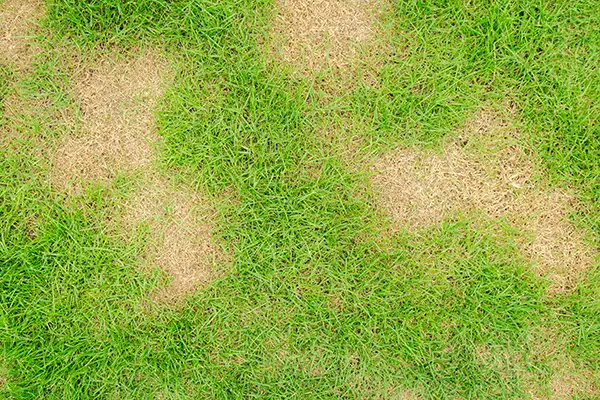Brown patch fungus is an unwelcome visitor in your yard that can wreak havoc on your lawn’s appearance and, more importantly, pose a threat to your grass’s health.
How can you treat this fungus and restore your lawn’s beauty? The right fungicides, along with proper feeding and aeration, are key. However, a tailored approach considering your local climate, the specific fungus strain, and your lawn’s unique needs is essential for long-term success. Working with a professional can help ensure you use the most effective treatment plan for your specific lawn.

This is where Bug Out’s customized care plans and local expertise make a difference. We offer solutions tailored to your lawn’s specific needs, including the type and severity of fungus.
What Is Brown Patch Fungus?
Brown patch fungus, or Rhizoctonia solani, is a disease that thrives in the humid warmth of places like Florida. It appears as brown, circular patches of dead grass that spread quickly, often causing significant damage to your lawn before you realize the extent of the problem. Regular monitoring and prompt action are crucial to prevent it from overtaking your entire lawn.
Why Do I Have Fungus on My Lawn?
The presence of brown patch fungus is often the result of a combination of factors that encourage fungal growth. These include:
- High humidity paired with warm nighttime temperatures: These summer conditions create an ideal environment for fungal growth.
- Over-fertilization: Too much nitrogen, especially from quick-release fertilizers, promotes lush foliage that is more prone to disease.
- Compacted Soil: Poor soil drainage leads to excess moisture, which fungi thrive in.
- Thick Thatch: A dense thatch layer blocks air circulation and traps moisture, providing a perfect habitat for fungi.
- Overwatering: Excess moisture in the soil creates favorable conditions for brown patch fungus.
Need Lawn Care? We Can Help.
Click the button below to leave your information & we'll be in touch in an hour or less.
Need Pest Control Service?
Leave your information below and we’ll be in touch with a FREE quote!
"*" indicates required fields
*During normal business hours. After hours calls will be returned the next business day.
Methods for Preventing Lawn Fungus
Fungal infections can seriously harm your lawn, and once they appear, they can be tough to eliminate. Fortunately, with proper care, you can minimize the chances of your lawn developing fungus. Here are some of the best prevention methods:
- Avoiding Overwatering Your Lawn: Overwatering promotes a moist environment perfect for fungi to thrive. Water your lawn deeply but infrequently to maintain a healthy balance.
- Fixing Any Drainage Issues: Poor drainage causes water to pool, leading to fungal growth. Ensure proper drainage to prevent excess moisture from accumulating on your lawn.
- Applying Fertilizer Twice Per Year: Fertilizing your lawn twice a year strengthens grass and helps it resist fungal infections. Apply in spring and fall for the best results.
- Mowing Regularly: Mowing keeps grass healthy and reduces the moisture where fungi can thrive. Maintain a consistent mowing schedule and avoid cutting the grass too short.
- Routinely Aerating the Soil: Aeration allows air, water, and nutrients to penetrate the soil, helping to prevent fungal growth. To ensure your lawn stays healthy, aerate it annually.
- Removing Thatch Buildup: Thatch buildup creates a damp environment that fosters fungi. Remove excessive thatch to improve air circulation and reduce the risk of fungal infections.
- Getting Expert Lawn Care: Professional lawn care experts can identify early signs of fungal infections and apply the right treatments. Regular care from a specialist ensures long-term lawn health and fungal prevention.
What to Do If You Have Lawn Fungus
Treating fungus is challenging, and lawn infections are no different. If you detect any signs of disease in your grass, taking swift action is essential to avoid widespread damage.
To ensure accurate diagnosis and treatment, it’s a good idea to consult a local lawn care professional. They can help identify the specific fungus and uncover any underlying issues affecting your lawn’s health, offering tailored solutions. Their expertise can also save you time and money by preventing the need for costly treatments that might not address the root cause.
